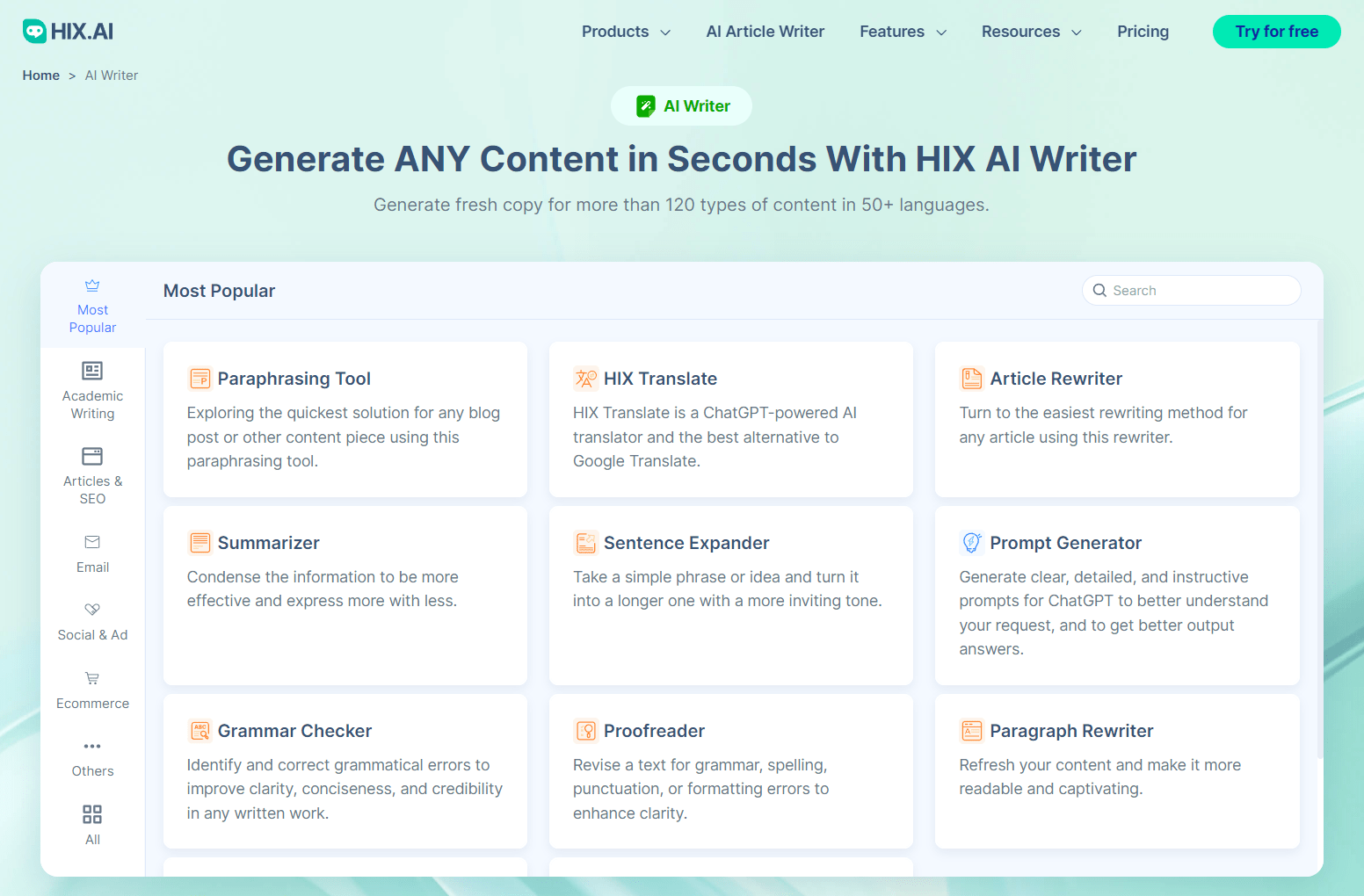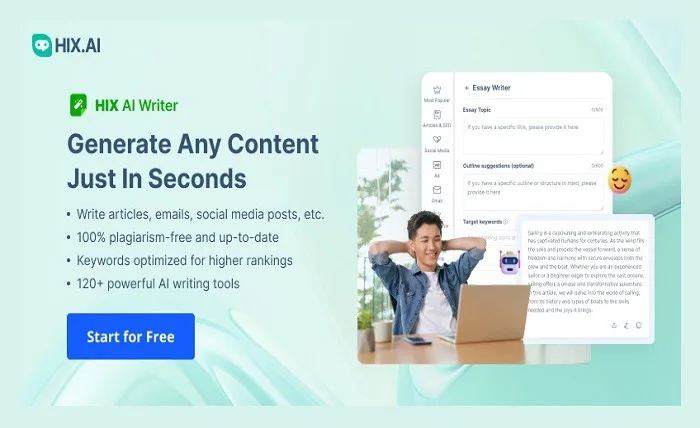For those unfamiliar with how AI writing tools work, they are essentially comprised of a mix of machine learning and natural language processing models that are fed a massive amount of content from a wide range of online sources to learn from. This data is usually pulled from millions of web pages, blog articles, online dictionaries, social media posts, e-books, and more.
Then, based on the user’s description of the desired content and their selected style inputs, the software program quickly works to produce a full-length content piece. For example, the AI text generator from HIX.AI offers access to 120+ writing tools that can help you streamline a wide range of tasks such as content generation, rewriting existing text, grammar checking, researching topics, translating text, and so much more.
While it is true that the generated text these tools produce may not always be perfect, when combined with human input, these tools can be a great way to quickly scale content output and lighten one’s workload. To this end, let’s quickly dive into some of the main pros and cons that typically come with using AI writing tools.
What Are The Pros and Cons of Using an AI Writer?
While several people out there may have differing opinions on the use of AI writing tools, the fact is that these tools can offer a wide range of benefits that are difficult to ignore. Some of the pros that come from using an AI writer tool, according to HIX.AI, include:
- Boosts content creation speed by almost 5 times
- Helps overcome writer’s block through AI-based content suggestions
- Makes it easier to create SEO-optimized content
- Ensures that there are fewer content writing mistakes
- Enables users to instantly craft content in multiple languages
- Speeds up the content research process significantly.
On the flip side, it is important to recognize that AI writing tools do come with their own set of limitations. As mentioned before, these tools are not perfect, and while they can optimize one’s writing workflow, there are still some drawbacks to consider. These include:
- Fails to replicate human emotion
- Still requires human touch
- Unable to generate creative ideas
How to Get the Most Out of an AI Writing Tool?

If you want to use AI writers like HIX.AI to consistently produce high-quality content, there are a few important things that you need to always keep in mind, and they can be summarized as follows:
1. Define the content’s purpose.
You must take the time to define the purpose of the content. This is what will provide you with a clear idea of what it is exactly that you want the AI writer to produce. In most cases, this means determining what the main goal is, figuring out who your target audience is, knowing what the tone of the content should be, breaking down what topics you want to cover, etc. If you have all this information laid out, then you will be able to move forward to the next step with complete clarity.
2. Provide the tool with a detailed brief.
All AI writing tools will usually require you to provide them with details about the type of content you want them to generate. It is for this reason that it helps to have a clear definition of the content’s overall purpose. In addition, you will need to be very clear and precise with your instructions.
After all, the more vague you are, the less accurate the generated content will be. This means avoiding any grammatical or spelling errors that can potentially confuse the AI writing tool. It also helps to include contextual information, like the intended target audience, for example.
3. Review the generated content.
As we’ve already established, AI writing tools are not foolproof. This is because they are only able to mimic the text that they have pulled from online sources, which means that there is a chance the content may not always be accurate or even contextually relevant.
To this end, it is important to always take the time to review and make the necessary edits
to the generated text to ensure that it is in complete alignment with its initial purpose. If you do spot inconsistencies in certain parts of the text, then you can always update the prompt to generate more accurate information.
4. Keep an eye out for plagiarism.
One of the biggest challenges when it comes to content creation is dealing with plagiarism, and AI tools are not exempt from this. There are times when they can end up generating identical content that could potentially compromise the integrity of your posts.
And while most AI writers, like HIX.AI, come with built-in plagiarism checkers, you should never neglect to double-check the generated text for originality. Before publishing any content, it helps to use other third-party checkers to be sure. Alternatively, you can paraphrase the generated text to be 100% confident that the text is clear.
5. Weave in your brand voice.
While AI writers can make the content creation process much easier and faster to handle, you should make an effort to include your human input in the final draft. After all, if you want to ensure the content engages readers, then you need to make sure it sounds and feels like something you wrote yourself.
This means including real-life examples, client stories, or even personal anecdotes. If possible, you should also try to dig a bit deeper and include additional research to make the content even more authoritative. Ultimately, the point is to ensure that the content doesn’t feel bland or lacking in personality.
6. Assess the content’s performance.
Finally, you must always take the time to assess the AI-generated content’s performance among online audiences. This usually means reviewing tracking metrics such as shares, engagement, bounce rates, and conversions. In doing so, you will be able to see just how effective the content was and if any improvements need to be made to ensure that you are getting the most out of using these AI writing tools.
Conclusion
A vast number of content writers and marketers tend to have strong opinions on the use of AI writing tools. However, the fact of the matter is that these tools have advanced in numerous ways over the past few years. As a result, they now offer more benefits than drawbacks, which is why you should consider implementing them into your daily workflow if you haven’t already.
That being said, you should also keep in mind that these tools are not meant to replace human input but rather supplement it. In other words, you still need to place a fair amount of effort into crafting, editing, and polishing any generated text, as well as weaving in your unique brand voice and personal experiences. This, in turn, will ensure that you can consistently churn out more content without ever having to compromise on quality.



